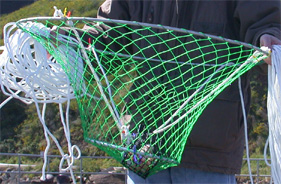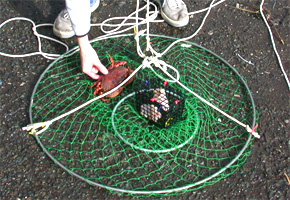Welcome to Jeff's Captivating
Guide to Crab Fishing. This guide was designed so readers with
no prior knowledge of crabbing could learn everything they need
to know to get started. It is based off my experience catching
Red Crabs in San Francisco. Enjoy!
Intro - About the Author
- Basics and Gear - Rig
Assembly - Let's Do It - Final
Words - An Update! (11/19/'06)
Introduction -
It's unfortunate that most people think of
catching crabs as an itchy, painful, experience involving ointments,
lotions, and visits to the local health clinic. If you've come
to this page because you're seeking medical advice or treatment
I can only offer you a link
to the CDC.
However, if you're
looking to add excitement to your life, take up a new hobby, or
provide yourself a cheap alternative to Red
Lobster you've come to the right place.
Welcome to the exciting
world of crab fishing aka "Crabbing".

About the Author -
I wasn't always a "Crabber". In
fact, if you had asked me three years ago if I were going to take
up crab fishing I would have denied it unfalteringly. My deliverance
into the world of crabbing was partly out of circumstance, but
more out of curiosity. After a brief introduction to college life
at SDSU I decided to get away from home and transfer to SFSU.
Being an ocean-loving San Diego native who was scuba certified
at 13, and an active long boarder long before that, adjusting
to life in San Francisco was not easy. San Francisco is home to
one of the largest populations of Great
White Sharks in the world. With shark attacks occurring about
every three months at beaches within a 15 minute drive of my house,
there was (and still is) no way in hell I was going to dress up
in an all black suit and swim around. Surfing (or any ocean contact
more than ankle deep) was pretty much out of the picture.
That being said, my ocean activities were pretty much limited
to tide pooling and hiking at picturesque places with ocean views.
During one of my outings I came across a public fishing pier under
the Golden Gate Bridge.
There were people fishing of course, and as I began looking in
people's catch buckets I came across one full of these bright
red crabs. Seconds became hours as I gazed in amazement at the
sight before me. I had never seen crabs outside of a tide pool
or the local grocery store tank. These individuals had managed
to capture a whole bucket of them, and I was determined to find
out how. After setting up an observation post, not entirely different
than the kinds of set ups the FBI or CIA uses, I had the basic
information I needed to get started. I'm not an expert. Everything
I know has been learned from experience and this page may very
well provide information which is not scientifically correct.
I'm a communications major, not a biochemist.
The
Basics-
The basic fundamental principal of crabbing is to use a baited
net to catch crabs off the ocean floor. You will need at minimum:
1) An area which crabs inhabit -
From what I can tell they're all over the Bay Area. In San Diego
you won't find any. I think they like cold water.
2) An access point to get to the water -
A pier and/or boat work very well. I have had excellent success
off piers and have never tried off a boat. The key is getting
out to deeper water out of the tide pooling zone and having a
relatively stable platform to work from.
3) A hoop net (bait
cage optional although HIGHLY recommended) -
This
is a hoop net

It's more
or less two stainless steel rings with an interwoven nylon net.
The bait cage (or bait box) is the black box fixed inside the
net and securely attached at the bottom. Mine was $12, the bait
cage was an additional $4. Call up tackle shops to purchase both
these items.
4) Some
rope -
I use generic clothesline rope (as pictured). I picked the cheapest
one at Home Depot . Retrospectively,
I should have purchased rope that wouldn't soak up water and take
two days in the sun to dry. The length of your rope will depend
on the depth at which you are fishing. You can always buy too
much and save it for other projects. Familiarize yourself with
fishing
knots. More on this later.
5) Misc
Hardware as Needed -
Be prepared to buy a couple more things at home depot while you're
there. I would recommend a package of zip ties (whatever is cheapest)
a metal ring (1/2 -1" diameter) I'll explain what this is
for later as well.
6) Bait
-
I'm still experimenting with types of bait. I've had exceptional
success with chicken. Think of it this way, would you rather have
a hot dog, or dinner at a fancy restaurant with exotic food? Crabs
use the same logic. They want something unique, the smell of chicken
attracts them and stands out. I see lots of "regulars"
at the pier using squid and dead fish as bait and they come up
empty handed almost every time. Trust me on this one, crabs dig
chicken. Go to the store and get the cheapest chicken you can
find. Don't spend more than 5 dollars as you will just be throwing
it away. Get something with bones, the bones will make it difficult
if not impossible for the crabs to suck the chicken out through
the grill on the bait cage and run off with it. This increases
the "Bait Reusability Factor" (BRF). Managing your BRF
is important, the more fresh the bait - the stronger scent it
emits through the water. Select a bone-containing chicken product
that comes in small portions such as drumettes or wings. If you
get drum sticks the price starts going up. The important thing
to note is that you want something that gives you the flexibility
to refresh the bait frequently with the least amount of cost.
You could get a package of 15 chicken wings and it would allow
you 15 bait changes. Quantity doesn't matter in your bait cage,
it's the smell.
7) A Fishing
license -
Without one, your little crab trip could cost you jail time. It's
not worth it. Please click here for pricing and licensing
information from the California Department of Fish and Game.
8) A bucket
to put your crabs in.
9)Munchies, a chair, maybe even a book, and some free time.
The
Method -
First, assemble all of your pieces and parts. Take your rope and
cut three identical pieces, you'll want to make them a little
longer than a foot (12") so you have room to tie knots on
both ends of it. Once you have your three pieces of rope, close
your eyes and imagine a "peace" symbol, if you cannot
envision that, try the mercedes logo. You're going to want to
attach the three pieces of rope to the outer ring of your crab
net so that when you stand directly over it the three pieces of
rope form that symbol, converging at the center. Reinforce your
knots with the zip ties. Make sure they will not easily slide
around the outside of the crab net. you need to be able to throw
this thing off a 15 foot pier and not have the knots shift on
you. Next, pick up the loose rope ends in the center of your crab
net and tie them to the metal ring. Reinforce with zip ties as
necessary. If one of these breaks off, you'll lose your crabs.
Lastly, take the rope you have left and tie it to the ring. This
knot is _very_ critical. If this knot fails you lose the entire
rig. Use the zip ties and pick a knot that will not unravel. I
forget which knot i used at the time. Here's how it should look
once you've finished.

When you lift it up, the whole thing should be balanced if you've
done everything correctly. You can see in the photo above that
mine is close, but not perfect as it leans to the left. As long
as it is relatively balanced, you should be ok.
Now is
the time to attach your bait cage, I used zip ties and detach
the cage when not in use to avoid unnecessary strain on the net.
Use about 3 or 4 zip ties and place it in the center of the inner
ring.
*** A suggestion from Andy, crabbing enthusiast ***
If I may make a suggestion...Get rid of the clothes
line. I think something like a braided nylon cord
will fit the bill, but you want something a bit more
pliable for tieing knots. When I was in the Army, I
got a bit of experience with knots (usually 550 cord,
a/k/a parachute cord), and can recommend the bowline
knot. Just leave a little extra and tie it, in an overhand
knot, over the cord leading back to your ring-that
gives added security. It's easier to show you than try to
explain, I'm afraid. But, If you are using the right
knots and the right cord/rope, you don't need the
security of all those zip ties.
Anyway, that's my two cents.
Let's
Do It -
Go find
your pier/boat/kayak and take your new crabbing rig with you.
Make sure you bring extra zip ties (10-15) and a utility knife
or pair of utility scissors. Fill your catch bucket with water
ahead of time before you even start fishing and get your snacks
and chair out. Bring gloves if you want.. things get messy. Do
not eat snacks with the same hands you catch the crabs with, that's
just disgusting. Open up your bait cage and put in one or two
pieces of the chicken bait you selected. This next step is important,
zip tie all four sides of the lid shut. You would be right in
assuming the crabs probably cant get the bait out with the standard
neoprene fastening strap (standard on bait cages) but what you
need to recognize is that lots of other animals like chicken too
especially octopus. I nearly learned this the hard way when an
octopus stretched the neoprene strap and stole my bait.. then
I thought I would be clever and put a zip tie in place of the
strap. Well, then the octopus found my rig again and decided to
bend back the entire hinge side of the lid and when I pulled it
back up the lid was dangling by one little zip tie. Needless to
say, zip tie all four sides.
Grab the
hoop in front of you so that the hoop is parallel with the ground
and toss is like a giant frisbee into the water. Keep hold of
the line and feed it out as needed. I try and avoid letting out
excess line as it could get snagged etc. Once you feel the rope
stop pulling, let out a little more, tie the excess to the pier
somewhere, take a look at your watch, and eat your snacks.
Wait anywhere
from 5-10 minutes (depending on your bait and the amount of crabs
in the area) and then pull the rope up quickly but calmly. If
you're lucky, you'll have crabs. Check to see if they're legal
(Red Crabs need to be 4 inches across the back) and if they have
both claws (more to eat) and you want to save them, drop them
in the bucket. That's all there is to it really.

Final
Words -
Once your done crabbing for the day, rinse everything off (especially
the bait cage with the raw chicken) and wash your hands. Additionally,
I store my crab net vertically with the bait cage detached and
I took a piece of rope and tied the two steel rings together to
avoid the constant pull of the lower ring on the net.
This guide
is a work in progress, my future plans are to experiment with
glow sticks, led lights, cameras, and putting a small float above
the metal ring to keep the rope from falling on the net while
under water. I don't know very much about crabs except that they
are territorial since they fight in the bucket. With this being
said, I don't think two large males will approach the bait cage
at once.
If you
have any suggestions, comments, or questions, send them to me
by e-mailing jeff@heff.net.
An Update -
Since publishing this guide I have received hundreds of e-mails from people all over the
world and all walks of life. I read and appreciate every single one of them. Every once and a while, an email stands out from among the rest either
because it contains photos of a successful crabbing trip or, even better, valuable crabbing tips. Ben, an experienced crabber from the Bay Area with
over 25 years of experience recently wrote such an email and I have included his message below with some comments. Also, for the first
time ever, my ‘secret’ crabbing spot is revealed.
“I’ve been crabbing in San Francisco for over 25 years [and] I’ve spoken to a lot of old timers and they all have theories and things they try. Some say it’s best to go crabbing during a full moon. Some tell me the opposite and that it’s best when there is no moon. They say it’s best during high tide, and some say low tide, daytime, night time. Man, I say “Just throw the damn ring into the water.”
Just a few things you could add to your article: You might want to mention that the bait cage is a must in SF Bay because there are a million seals there that’ll take your bait…and they laugh at you after they do it. [Jeff: This is ENTIRELY TRUE!] The place you mentioned is Fort Point [Jeff: Almost! My secret spot is actually here]. I found that on that pier, tide is not a factor. However, on the Municipal Pier on Van Ness or on the other side of the bay, you can only go crabbing during the highest tide or the lowest tide. Anytime in between, the trap will not settle at the bottom because the tide is too strong in those areas. You don’t need a fishing license as long as you’re on a municipal pier. Be careful not to catch Dungenous Crab. The fine is probably about $1,000 now. You need a commercial license to catch Dungenous. It’s bluish in color. The Rock Crab that is legal in SF Bay is red. [Jeff: Ben raises a good point, the type of crab you see at Albertsons or Vons is Dungenous, if you pull up something that looks like a crab you’d buy at the store, toss it back – it’s illegal to catch inside the Bay unless you have a commercial fishing license. If you want to catch these, head down to the Pacifica pier.]
|




